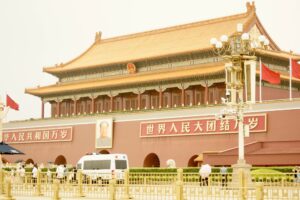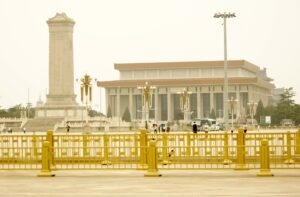In the dark, humid early hours of June 4, 1989, the sky above Beijing was ominously quiet, a strange calm hanging over a city bracing for something unspeakable. Beneath that sky, in Tiananmen Square—once a symbol of national pride and power, where dynasties once marched and where the Communist Party had long staged parades of strength—thousands of young people huddled together. Some sat quietly in groups, others lay down on concrete in exhaustion, arms linked, banners still clutched, their eyes darting in all directions as distant mechanical roars grew closer. They had been there for weeks, fueled by idealism, hope, and an unyielding belief that their voices could change the future. These were students, mostly. But they were also workers, artists, journalists, children of the revolution now calling for a new kind of revolution—one of transparency, democracy, and freedom of speech. What none of them could know that night was just how violent and irreversible the government’s response would be.
It had all started on April 15, 1989, with the death of Hu Yaobang, a former general secretary of the Communist Party. Hu had been a reformer, a figure of quiet moral authority among intellectuals and students, someone who had supported greater openness and had shown sympathy toward the very ideas that now echoed through the square. His death from a heart attack at age seventy-three might have passed with little fanfare under normal circumstances, but the timing, the political climate, and the mounting frustration with the Party’s corruption ignited a flame. Thousands of students poured into Tiananmen Square in mourning. They carried wreaths and banners, and many wore black armbands. But mourning quickly turned into protest as students seized the moment to demand something more. What began as a memorial evolved into a movement.
At first, it was peaceful. The square became a makeshift village. Students read manifestos, discussed philosophy and politics, and engaged in hunger strikes. There was an energy in the air—hopeful and righteous. Foreign journalists took note of the sudden surge of activism in China, a place that had for so long appeared closed off and silent under the grip of authoritarianism. There were banners calling for dialogue with the government, chants denouncing corruption, and homemade leaflets calling for constitutional rights. For the first time in decades, China’s youth appeared to stand in open defiance of one of the most powerful regimes on the planet. The students believed in the power of moral clarity. Many of them had been raised on stories of revolution, and they now felt they were taking up that mantle in pursuit of a better China.
But the Communist Party did not see this as noble. It saw a threat. Party elders, particularly hardliners like Premier Li Peng and Deng Xiaoping, feared that this gathering could embolden opposition across the country. The memory of the 1986 protests—which had been quickly suppressed—was still fresh in the minds of many leaders. And now, the world was watching. With cameras broadcasting live to global networks and foreign dignitaries visiting China for trade and diplomacy talks, the protests in Tiananmen became not just a domestic issue, but a test of the regime’s image abroad.
By late May, the leadership had grown impatient. Martial law was declared on May 20. At first, the military attempted to enter the city, but were met by barricades of residents—taxi drivers, cyclists, and ordinary Beijingers—who blocked their advance. This act of collective defiance shocked the military and enraged the leadership. For a brief moment, it looked like the protestors had won a moral victory. The soldiers were pulled back. Crowds cheered. It seemed that the voice of the people might actually succeed in forcing reform, or at the very least, negotiation.
But behind the scenes, preparations were underway for a different kind of response. A secret decision was made by the Standing Committee: they would clear the square by force. The People’s Liberation Army, tasked with protecting the nation, was about to turn its guns inward. Multiple divisions were brought in from distant provinces—soldiers who had no connection to the citizens of Beijing, men who would not be swayed by cries from fellow Chinese pleading for mercy. And they were given a mission that would stain the nation’s history forever.
On the night of June 3, columns of tanks and armored personnel carriers began moving toward the city center. Troops carried live ammunition. Orders were clear: clear the square by dawn, at all costs. Around 10:30 p.m., the first shots were fired in western Beijing, near Muxidi. Soldiers fired into crowds that had gathered to block their advance. Eyewitnesses recalled the horror—bullets ripping through crowds, people falling in the streets, screams mixing with the roar of engines and the clang of steel against pavement. Ambulances were not allowed through. In many cases, residents used bicycles or pulled carts to carry the wounded to hospitals. Blood pooled in gutters. There was no warning, no attempt to disperse the crowds peacefully.
As the night progressed, the violence spread. Troops opened fire on civilians on footbridges and in alleyways. Parents watched in helpless terror as their children, who had gone out to protest with banners and songs, did not come home. Some fell trying to help others. Others were crushed beneath the treads of tanks that rolled over makeshift barricades and bodies alike. The sounds of gunfire echoed across the city. Telephone lines were cut. Foreign journalists were assaulted or detained. Cameras were smashed. The regime wanted not just to end the protests—it wanted to erase all evidence of them.
By dawn on June 4, the square was surrounded. Some student leaders negotiated with officers to allow peaceful evacuation. By then, however, the violence had already reached its peak. Some students were allowed to leave in small groups. Others refused. Many were beaten. Some were shot. Despite rumors and myths that the square itself was spared the worst of the bloodshed, numerous witnesses insist that there were shootings and killings inside the square as well. One particularly haunting account recalls a line of tanks plowing through the square and opening fire indiscriminately, even after most of the students had already left.
And then came silence. By mid-morning, the square was cleared. The Goddess of Democracy had been toppled and smashed. The ground was littered with abandoned banners, burned tents, torn clothing, and pools of blood. Soldiers stood guard, their rifles still loaded, as if expecting the dead to rise again. In nearby hospitals, doctors and nurses struggled to treat the flood of wounded. Blood supplies ran low. Some hospitals were ordered to stop accepting patients. Others were raided, and bodies were removed by military trucks. The government took extraordinary measures to hide the scope of the massacre. Families of the dead were told to remain silent or face consequences. Death certificates often listed false causes of death. Morgues were sealed. Evidence was burned.
In the following days, the Chinese state began a sweeping crackdown. Arrests soared. Hundreds of protestors, sympathizers, and bystanders were detained. Some were tortured. Trials were swift and opaque. Many were sentenced to long prison terms. A few were executed. The government also launched an aggressive propaganda campaign to reframe the narrative. State media denounced the protestors as “counterrevolutionary rioters.” Footage was doctored. Facts were buried. Entire swaths of the population were kept in the dark. For those who had witnessed the events firsthand, the psychological trauma was immense, compounded by the enforced silence.
And yet, out of this darkness came one of the most iconic acts of resistance in modern history. On the morning of June 5, a lone man in a white shirt, holding two shopping bags, stood in front of a column of tanks on Chang’an Avenue. The lead tank swerved left. The man moved to block it. The tank swerved right. Again, the man stepped in front. He clambered onto the tank, spoke to the soldiers inside—what he said, no one knows. Eventually, he was pulled away by onlookers and vanished into the crowd. His name was never confirmed. Some say he was executed. Others believe he escaped and lives in hiding. But “Tank Man,” as he became known, remains one of the most enduring symbols of human courage—a reminder that even in the face of overwhelming force, one person can still make the world stop and look.
Today, in China, the events of June 4 are an open secret—something millions know but cannot discuss. The government has banned all mention of Tiananmen from textbooks, news articles, and online platforms. Even the numbers “6-4” are censored on Chinese social media. Activists who attempt to commemorate the day are arrested. In Hong Kong, once the last bastion of public mourning for the massacre, candlelight vigils have been banned and organizers prosecuted under new national security laws. The Chinese state has invested enormous resources in scrubbing Tiananmen from its collective memory.
But outside China, the memory endures. In cities around the world, statues of the Goddess of Democracy stand in solidarity. Human rights organizations continue to demand accountability and recognition for the victims. Exiled Chinese dissidents tell their stories, year after year, so that the truth cannot be fully buried. In universities, museums, and independent media, the massacre is studied as a grim warning of what unchecked power can do when it fears the voice of its own people.
For those who cherish democracy, June 4 is not just a moment of mourning—it is a call to vigilance. It is a reminder that authoritarian regimes do not merely seek obedience; they seek to rewrite history itself. They aim to erase the memory of resistance so thoroughly that future generations will have no language to describe what freedom once looked like. But the ghosts of Tiananmen are not so easily vanquished. They live on in the stories passed down from mother to child, in whispered memories, in the eyes of those who survived but carry the scars.
The massacre did not end the fight for democracy in China. In many ways, it simply drove it underground. Activists continued to organize, albeit in secret. The internet gave rise to new methods of dissent. The seeds planted by those students in 1989 still grow, even in the most unlikely places. The Chinese people have not forgotten—they have simply adapted, waiting for a time when it will be safe to remember aloud.
The events of Tiananmen Square remind us that history is not just written by the victors; it is preserved by the brave, the stubborn, the broken-hearted who refuse to let the truth die. And so, every year on June 4, around the world, candles are lit not only to honor the dead, but to renew a promise—that we will remember, that we will speak, that we will not let silence be the final word. The blood spilled that day cries out not for vengeance, but for remembrance. The courage of those who stood unarmed against tanks is not a relic—it is a living testimony to the resilience of the human spirit, to the idea that even in the face of brutal repression, the desire for freedom burns undiminished.


